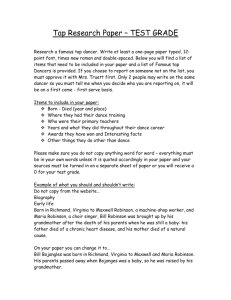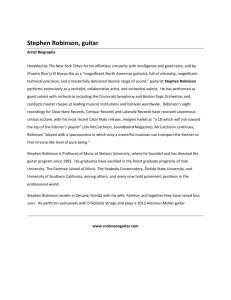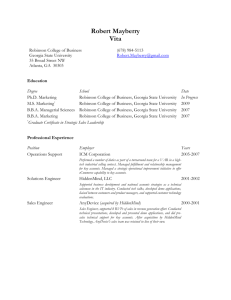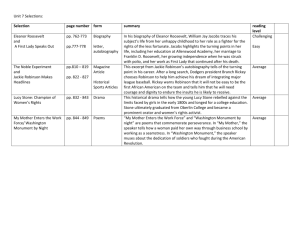Patient Centered Medicine: General Appearance Assessment
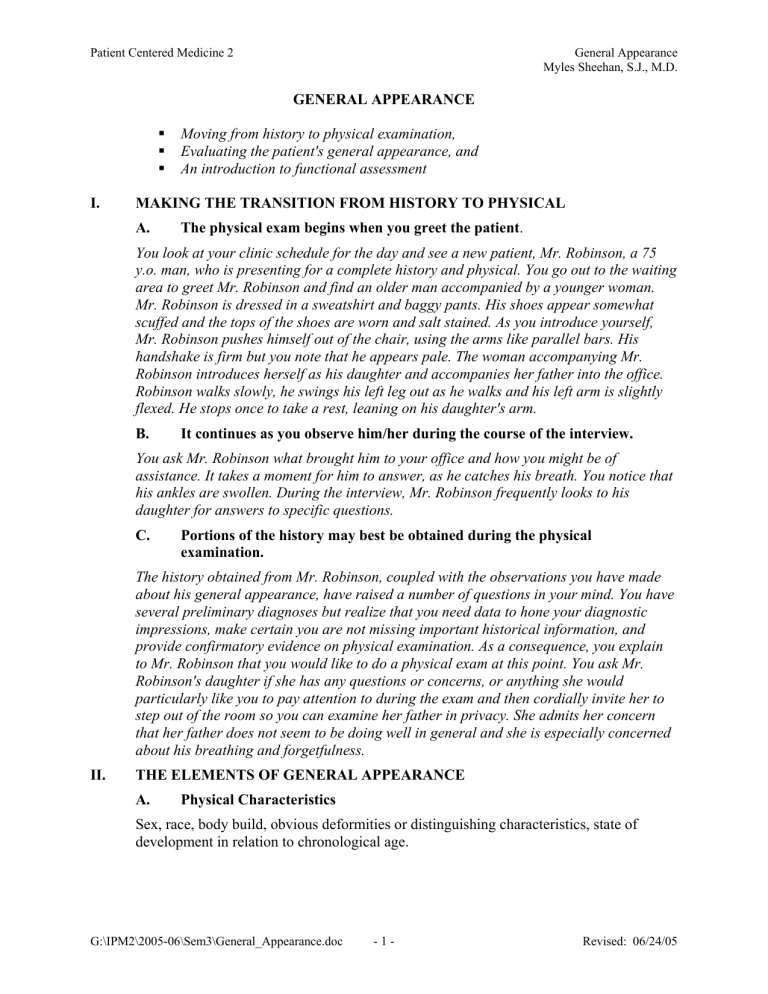
Patient Centered Medicine 2 General Appearance
Myles Sheehan, S.J., M.D.
GENERAL APPEARANCE
Moving from history to physical examination,
Evaluating the patient's general appearance, and
An introduction to functional assessment
I.
MAKING THE TRANSITION FROM HISTORY TO PHYSICAL
A.
The physical exam begins when you greet the patient .
You look at your clinic schedule for the day and see a new patient, Mr. Robinson, a 75 y.o. man, who is presenting for a complete history and physical. You go out to the waiting area to greet Mr. Robinson and find an older man accompanied by a younger woman.
Mr. Robinson is dressed in a sweatshirt and baggy pants. His shoes appear somewhat scuffed and the tops of the shoes are worn and salt stained. As you introduce yourself,
Mr. Robinson pushes himself out of the chair, using the arms like parallel bars. His handshake is firm but you note that he appears pale. The woman accompanying Mr.
Robinson introduces herself as his daughter and accompanies her father into the office.
Robinson walks slowly, he swings his left leg out as he walks and his left arm is slightly flexed. He stops once to take a rest, leaning on his daughter's arm.
B.
It continues as you observe him/her during the course of the interview.
You ask Mr. Robinson what brought him to your office and how you might be of assistance. It takes a moment for him to answer, as he catches his breath. You notice that his ankles are swollen. During the interview, Mr. Robinson frequently looks to his daughter for answers to specific questions.
C.
Portions of the history may best be obtained during the physical examination.
The history obtained from Mr. Robinson, coupled with the observations you have made about his general appearance, have raised a number of questions in your mind. You have several preliminary diagnoses but realize that you need data to hone your diagnostic impressions, make certain you are not missing important historical information, and provide confirmatory evidence on physical examination. As a consequence, you explain to Mr. Robinson that you would like to do a physical exam at this point. You ask Mr.
Robinson's daughter if she has any questions or concerns, or anything she would particularly like you to pay attention to during the exam and then cordially invite her to step out of the room so you can examine her father in privacy. She admits her concern that her father does not seem to be doing well in general and she is especially concerned about his breathing and forgetfulness.
II.
THE ELEMENTS OF GENERAL APPEARANCE
A.
Physical Characteristics
Sex, race, body build, obvious deformities or distinguishing characteristics, state of development in relation to chronological age.
G:\IPM2\2005-06\Sem3\General_Appearance.doc - 1 - Revised: 06/24/05
Patient Centered Medicine 2 General Appearance
Myles Sheehan, S.J., M.D.
Who cares?
Sex: Influences your prior probability of certain diagnoses, helps differentiate findings during development.
Race: Especially pertinent with certain diagnoses, e.g. sickle cell anemia, thalassemia. Be cautious, however, about confusing stereotypes with reality.
Body build: Is the person very tall and skinny? Are they short and squat? Height and weight are extremely useful pieces of data in following a person. First, it gives objective data to verify your clinical impression (e.g., 6' 1" and 140 pounds is quite thin and makes one wonder why the person does not weigh more). Second, serial measures of weight provide evidence for systemic illness or another problem that may need investigation
(e.g., if the 6' 1" man now weighs 140 pounds but six months previously weighed 165, then you have objective verification of a 25-pound weight loss and, if the cause is not obvious, a need to determine a reason for the weight loss like depression, malignancy, severe illness, etc.).
Obvious deformities and characteristics: Is there anything that catches your eye when you see this person? Examples: Is there a facial droop that might make you think the person has had a stroke or Bell's palsy? Is it a middle-aged woman with a rash and alopecia that might mean lupus
Development in relation to chronologic age: Particularly relevant in childhood and adolescence, a boy or girl in their late teens without evidence of secondary sex characteristics would raise a number of alarms.
B.
Does the patient look sick or uncomfortable?
Level of Alertness
This may seem obvious, but it is important to note if the patient is awake, attentive, cooperative, or lethargic, stuporous, or in a coma!
Apparent State of Health
Think about what it means for someone to look sick. Does the patient look excessively thin or cachectic? Is there evidence of temporal wasting? Are they pale? Diaphoretic?
Wincing in pain?
Apparent State of Comfort or Distress
Is the person telling you that they have crushing chest pain and cannot breathe yet are sitting still, smiling, and appear to be breathing comfortably?
Respiratory Rate
Breathing rate and pattern can be a good clue to diagnosis.
Normal respiratory rate in an adult is 14-20. Rapid breathing may be a sign of anxiety, respiratory distress (asthma, pneumonia, etc.), a systemic illness (sepsis, diabetic ketoacidosis).
Breathing type and pattern is worth noting, e.g., pursed lip breathing, Cheyne-Stokes respiration.
G:\IPM2\2005-06\Sem3\General_Appearance.doc - 2 - Revised: 06/24/05
Patient Centered Medicine 2 General Appearance
Myles Sheehan, S.J., M.D.
C.
What is the person's mental status?
Formal mental status testing will be pursued later. At this stage, recognize that if the person somehow seems peculiar (this is not derogatory) or you are finding it very hard to get a history, or the person is confused, or the patient seems sad, anxious, or inappropriate, then you need to think a bit about what is going on with the person and be willing to pursue a few questions.
D.
What is the impact of illness on the person?
This has two components that are closely interwoven. The first is the person's emotional response to illness. The second is how the person's ability to take care of herself/himself has been altered. This second component is a large element of determining a person's functional status. Functional assessment consists of observing the patient's general appearance, asking the person specific questions about his/her ability to perform the activities of daily living and instrumental activities of daily living, and, during the physical exam, watching the person perform tasks like dressing and undressing, get up and walk from a seated position, etc.
III.
SOME SPECIFIC ISSUES
A.
How do you communicate general appearance?
Presentation of the physical examination, either in writing or verbally, should begin with a pithy description of the patient that makes it clear to all what the person looks like.
Descriptions like "Well-developed, well nourished white male in no acute distress" are useless, a waste of time, provide no information, and show a profound lack of imagination on the part of the examiner. Do not feel obliged to use medical language when standard image conveys the picture more clearly.
B.
Some other points to observe
How is the patient dressed? What do their shoes look like (especially with older patients)? Who comes with the patient? If they are alone, why is this? If they are accompanied, why?
C.
Assessing Function
Activities of daily living (ADLs) are those tasks that an individual must perform during the course of a day to be independent in personal care. Instrumental activities of daily living (IADLs) are those tasks that a person needs to do to be able to maintain an independent existence. A list of ADLs includes bathing, dressing, toileting, transferring, continence, and feeding. IADLs are a bit harder to list and include shopping, arranging transportation, preparing food, using a phone, managing one's finances. With chronic illnesses, the IADLs tend to be lost first and the ADLs are lost as disability progresses.
Who cares? Detecting deficits in function may be more important than exhaustive diagnostic testing as one can tailor therapy to deal with the deficits and, frequently, improve quality of life.
In obtaining a history, one can ask specifically about ADLs and IADLs. In observing appearance, one gets a sense of functional limitations. In the physical examination, one can test specific functions: get out of a chair, ability to dress, etc.
G:\IPM2\2005-06\Sem3\General_Appearance.doc - 3 - Revised: 06/24/05
